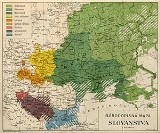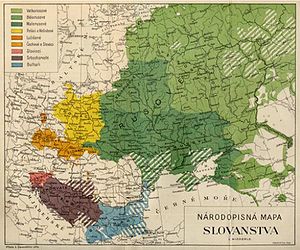
Balachka
Encyclopedia

Balachka is a term used to label the dialects spoken by Cossacks living in Russia. Originally the term was applied to the dialects of Ukrainian language
Ukrainian language
Ukrainian is a language of the East Slavic subgroup of the Slavic languages. It is the official state language of Ukraine. Written Ukrainian uses a variant of the Cyrillic alphabet....
spoken in the region around the Kuban
Kuban
Kuban is a geographic region of Southern Russia surrounding the Kuban River, on the Black Sea between the Don Steppe, Volga Delta and the Caucasus...
river, however the usage of this term has recently broadened to include the Cossack dialects spoken on the Don
Don River (Russia)
The Don River is one of the major rivers of Russia. It rises in the town of Novomoskovsk 60 kilometres southeast from Tula, southeast of Moscow, and flows for a distance of about 1,950 kilometres to the Sea of Azov....
, Terek, Ural
Ural River
The Ural or Jayıq/Zhayyq , known as Yaik before 1775, is a river flowing through Russia and Kazakhstan. It arises in the southern Ural Mountains and ends at the Caspian Sea. Its total length is 1,511 mi making it the third longest river in Europe after the Volga and the Danube...
and even those further out into Asiatic Russia and Central Asia
Central Asia
Central Asia is a core region of the Asian continent from the Caspian Sea in the west, China in the east, Afghanistan in the south, and Russia in the north...
.
The term originated from the Ukrainian term "balakaty'", which means to babble, and was originally was used in the Russian language as a derogatory term to describe the language used by the Kuban Cossacks which differed considerably from literary Russian.
For the Don Cossacks
Don Cossacks
Don Cossacks were Cossacks who settled along the middle and lower Don.- Etymology and origins :The Don Cossack Host was a frontier military organization from the end of the 16th until the early 20th century....
this was due to their historical proximity to Ukraine (Little Russia
Little Russia
Little Russia , sometimes Little or Lesser Rus’ , is a historical political and geographical term in the Russian language referring to most of the territory of modern-day Ukraine before the 20th century. It is similar to the Polish term Małopolska of the Polish-Lithuanian Commonwealth...
), and for the Kuban Cossacks
Kuban Cossacks
Kuban Cossacks or Kubanians are Cossacks who live in the Kuban region of Russia. Most of the Kuban Cossacks are of descendants of two major groups who were re-settled in the Western Northern Caucasus during the Caucasus War in the late 18th century...
due to their descendency from the Ukrainian speaking Black Sea Cossacks. The Kuban Cossacks group have two separate dialects, one is the Black-Sea Cossack group spoken in the Taman peninsula which is similar to literary Ukrainian, the second is the Mountainous regions of the Forecaucasus, where due to historical interactions with the Circassians population a different accent and vocabulary developed.
Some linguists characterize Balachka vernacular as a dialect or group of dialects. Balachka does not appear as a separate language on any language code
Language code
A language code is a code that assigns letters and/or numbers as identifiers or classifiers for languages. These codes may be used to organize library collections or presentations of data, to choose the correct localizations and translations in computing, and as a shorthand designation for longer...
s. Nevertheless, some Cossacks consider it to be a separate language and at least one academic case has been made in this regard.
Kuban-Black Sea Balachka
The most significant instance of the Cossack dialect is the Kuban-Black Sea Balachka. Originally starting as a central Ukrainian dialectUkrainian language
Ukrainian is a language of the East Slavic subgroup of the Slavic languages. It is the official state language of Ukraine. Written Ukrainian uses a variant of the Cyrillic alphabet....
used by the Black Sea Cossacks who moved to the Kuban
Kuban
Kuban is a geographic region of Southern Russia surrounding the Kuban River, on the Black Sea between the Don Steppe, Volga Delta and the Caucasus...
in 1792. Over the years the language began to acquire more Russian vocabulary, coinciding with the rising literacy rates in the late 19th century. The Kuban Cossack Chorus artistic director Viktor Zakharchenko points to the local folk songs dating to early and mid-19th century., where those that originated in the Kuban would have their own unique literary flavour and differ from those in standard Russian and Ukrainian. During the 1897 Russian census
Russian Empire Census
The Russian Imperial Census of 1897 was the first and the only census carried out in the Russian Empire . It recorded demographic data as of ....
the dialect was classified as Little Russia
Little Russia
Little Russia , sometimes Little or Lesser Rus’ , is a historical political and geographical term in the Russian language referring to most of the territory of modern-day Ukraine before the 20th century. It is similar to the Polish term Małopolska of the Polish-Lithuanian Commonwealth...
n language rather than Great Russia
Great Russia
Great Russia is an obsolete name formerly applied to the territories of "Russia proper", the land that formed the core of Muscovy and, later, Russia...
n. (See further down on the political aspects of this particular dialect).
Don Balachka
The historical closeness of the Don Cossacks with Ukraine led to mutual exchange of communication methods, between the two peoples. The Don Balachka is known for its soft sounds, for example идти idti (to walk) is said as итить ititRussian Civil War
The Russian Civil War was a multi-party war that occurred within the former Russian Empire after the Russian provisional government collapsed to the Soviets, under the domination of the Bolshevik party. Soviet forces first assumed power in Petrograd The Russian Civil War (1917–1923) was a...
a short-lived Don Republic
Don Republic
The Don Republic and later the Vsevelikoe Voisko Donskoe was an anti-Bolshevik state formed during the Russian Civil War after the collapse of the Russian Empire, and the name of two organizations formed in the 1990s....
was formed, and its leader Ataman
Ataman
Ataman was a commander title of the Ukrainian People's Army, Cossack, and haidamak leaders, who were in essence the Cossacks...
, Pyotr Krasnov
Pyotr Krasnov
Pyotr Nikolayevich Krasnov , 1869 – January 17, 1947), sometimes referred to in English as Peter Krasnov, was Lieutenant General of the Russian army when the revolution broke out in 1917, and one of the leaders of the counterrevolutionary White movement afterward.- Russian Army :Pyotr Krasnov...
suggested using the Don Balachka in favour of standard Russian though this did not gain much support.
Mountain Balachka
This Balachka differs uniquely from the other Cossack vernaculars in its free use of Circassian terms, particularly from modern Adygeya. This is explained by Russia's conquest of the Northern Caucasus where intensive interaction with the indigenous Circassian peoples resulted in their influence of Cossack dialect, and also in dress, music, dance and cuisine. Further south Karachay-CherkessiaKarachay-Cherkessia
The Karachay-Cherkess Republic , or Karachay-Cherkessia is a federal subject of Russia . Population: -Geography:*Area: *Borders:**internal: Krasnodar Krai , Kabardino-Balkar Republic , Stavropol Krai ....
and Stavropol
Stavropol
-International relations:-Twin towns/sister cities:Stavropol is twinned with: Des Moines, United States Béziers, France Pazardzhik, Bulgaria-External links:* **...
- the traditional home of the former Caucasus Line Cossack Host
Caucasus Line Cossack Host
Caucasus Line Cossack Host was a Cossack host created in 1832 in the Northern Caucasus. Together with the Black Sea Cossack Host it defended the Caucasus Fortified Defense Line from the inlet of Terek River to the inlet of Kuban River.In 1860 it was split into the Kuban Cossack Host and Terek...
, their accent has a greater Circassian influence, and is thus considered a balachka not by the initial definition but due to the term being becoming applied universally to all Cossack dialects. This is also true to the Vainakh and Avar
Avar language
The modern Avar language belongs to the Avar–Andic group of the Northeast Caucasian language family....
influenced dialect of the Terek Cossacks, sometimes also being referred to as a Balachka.
Modern Usage
It is not known how widespread the use of Balachka is. Education and strict requirements of the Russian Academy of SciencesRussian Academy of Sciences
The Russian Academy of Sciences consists of the national academy of Russia and a network of scientific research institutes from across the Russian Federation as well as auxiliary scientific and social units like libraries, publishers and hospitals....
mean that local press such as TV and radio adhere to standard Russian, with a notable exception for historical films (particularly those involving Cossacks) and Folk music
Folk music
Folk music is an English term encompassing both traditional folk music and contemporary folk music. The term originated in the 19th century. Traditional folk music has been defined in several ways: as music transmitted by mouth, as music of the lower classes, and as music with unknown composers....
groups and ensembles, such as the Kuban Cossack Chorus.
As a result there has been a gradual erosion in the use of authentic dialects and accents, with unique terms being slowly replaced by standard Russian ones. This is particularly noticeable in the younger generations. At the same time, beginning in the early 1990s, the re-awakening of the Cossacks movement was often done with rekindling of old traditions. It is thus not surprising that many Cossacks use Balachka (or some of its elements) in their speech to punctuate their Cossack heritage and/or affiliation.
Political aspects
Political aspects have played a direct role in the classification of the Kuban Balachka. Although this Balachka was initially officially classified as a dialect of the Little RussiaLittle Russia
Little Russia , sometimes Little or Lesser Rus’ , is a historical political and geographical term in the Russian language referring to most of the territory of modern-day Ukraine before the 20th century. It is similar to the Polish term Małopolska of the Polish-Lithuanian Commonwealth...
n language (the official term in pre-revolutionary Russia for the Ukrainian language
Ukrainian language
Ukrainian is a language of the East Slavic subgroup of the Slavic languages. It is the official state language of Ukraine. Written Ukrainian uses a variant of the Cyrillic alphabet....
) , and some Ukrainian sources actively support the idea of Balachka being a dialect of the Ukrainian language, this is being contested by some Russian linguistic research, and some of the Kuban Cossacks themselves, who point out that already by the 1860s there was a separate dialect that morphed out of Ukrainian and Russian..
See also
- SurzhykSurzhykSurzhyk refers to a range of russified sociolects of Ukrainian used in certain regions of Ukraine and adjacent lands. It does not possess any unifying set of characteristics; the term is used for "norm-breaking, non-obedience to or nonawareness of the rules of the Ukrainian and Russian standard...
- the use of Russian words on a Ukrainian grammar matrix. - Russenorsk - a pidgin language that combines elements of Russian and Norwegian
- DiglossiaDiglossiaIn linguistics, diglossia refers to a situation in which two dialects or languages are used by a single language community. In addition to the community's everyday or vernacular language variety , a second, highly codified variety is used in certain situations such as literature, formal...
- a situation of parallel usage of two closely related languages, one of which is generally used by the government and in formal texts, and the other one is usually the spoken informally

